In this article, my aim is to help you inject some humanity into your product-led growth strategy by sharing how we’ve built this approach into the DNA of our growth team at HubSpot Academy, sharing the five key lessons learned along the way.
Why do we talk about our users, as if we're running a military sting operation on them? I want to tell you some ways we can bring some humanity back in because that has been a really important part of the DNA of our growth team at HubSpot Academy.
Let’s inject some humanity back into our strategy
I recently made my first trip to London, an amazing city. It's funny though, my colleagues and my peers all had these interesting things to say about London before I traveled, they were like:
- "It has 8 million people, it's almost as big as New York City."
- "You have to go get tea here."
- "You've got to go get Indian food here."
- "You can't say awesome too many times in your presentation."
That built up this perception of London in my mind, I had not experienced it for myself, that was my reality. That's true for your products as well.
The perception your prospects have for your product is their reality.
How do you influence that perception?
London doesn't have a sales team to call me and say "It's going to be great. Big Ben is under construction, but everything else works. Christmas time is the best time to be in London". Right?
Same with your product, you don't have the ability to influence their perception. Well, actually, you do. You can do that for your customers.
What is HubSpot?
HubSpot has bet its business on a flywheel model. We used to use a funnel, where you attract demand in, you convert it into customers, and then that was kind of it.
But with the flywheel model, you take into account the power of your customers, the fact they're your biggest, loudest marketing team, the fact they're your most helpful support reps, and the fact they're your most efficient and consultative sales team. That's really powerful.
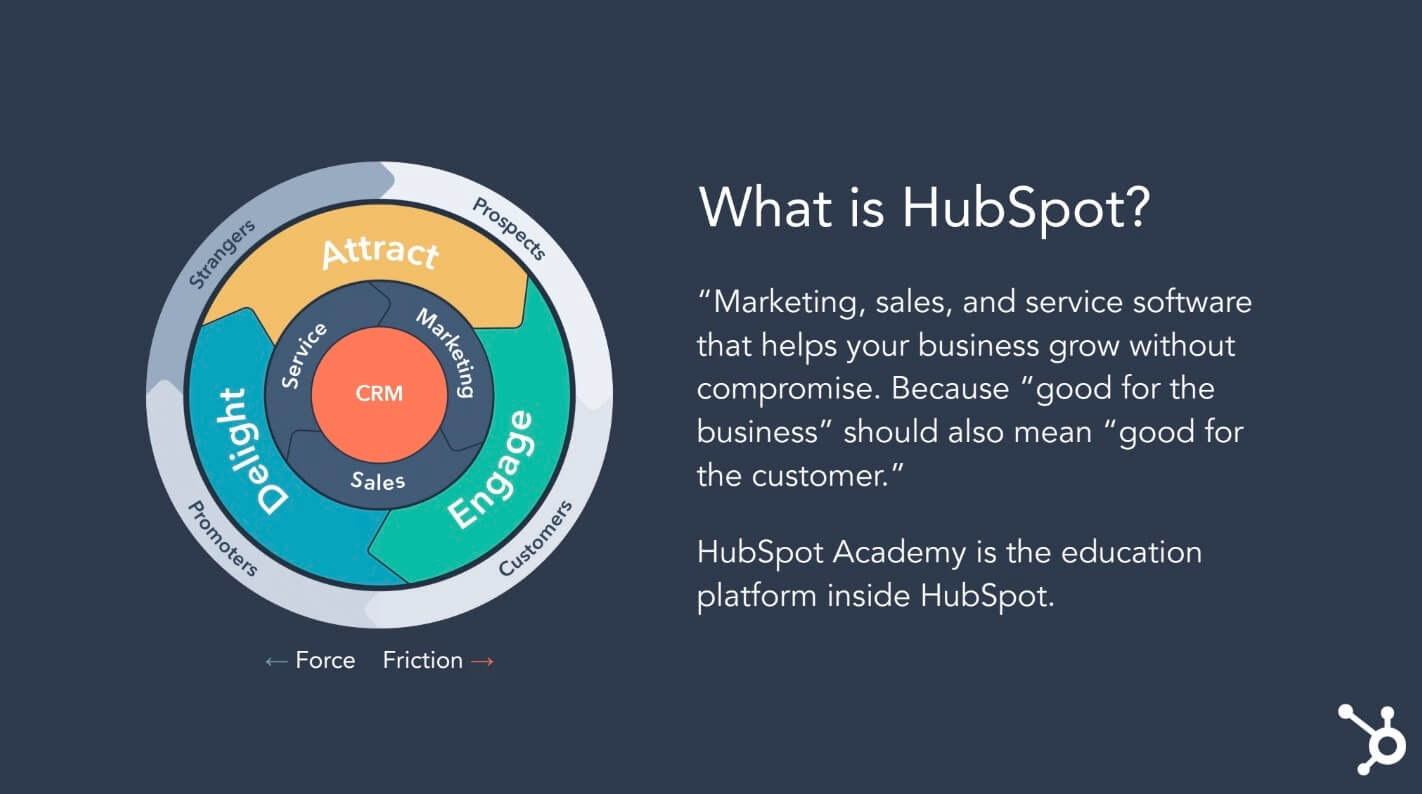
So we attract people in, we engage them, and we delight them. If you can delight them, if you can exceed their expectation, you can make them promoters.
It's in our human nature when we find something that we really like and it's exceeded our expectation to kind of brag about it. It makes you feel smart to go tell other people you found this cool thing. That's powerful.
The thing about marketing software
There's something you need to know about HubSpot that is key to the invention of HubSpot Academy. It serves very specifically small and medium-sized businesses. It is marketing sales and customer service software for small and medium-sized businesses.
So 20 to 200 people are in our target. More recently, it's more like 20 to 1,000 people but at the time of the founding of HubSpot Academy, it was smaller. It was specifically marketing software.
What we found was with marketing software, you can't just teach them how to use the software, we couldn't just create content to teach our customers how to use our software, we needed to teach them how to be really good at marketing as well.
Because if you take a bad marketer and give them marketing automation software, it's a productivity tool at the end of the day, it's going to just make them worse faster.
How HubSpot Academy started
So we needed to teach them how to be good at marketing, good at their jobs. That is how HubSpot Academy started.
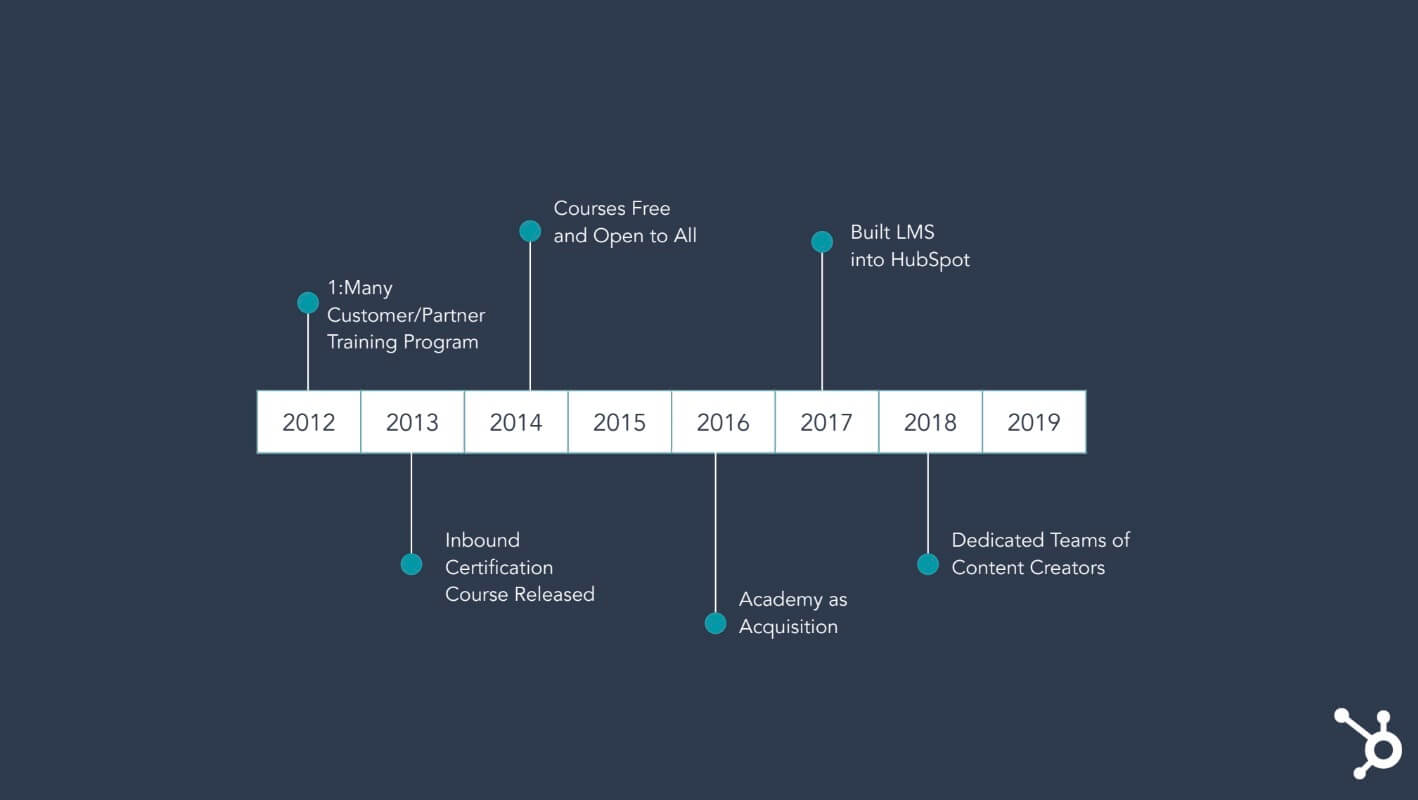
1:many customer/partner training program
It started back in 2012, as a one-to-many customer enablement and partner enablement channel. We had on-demand webinars to teach our customers how to use the software and how to be good at marketing.
Inbound certification course released
In 2013, we released the first inbound certification. This course taught nothing about the software, it was purely a very modern digital marketing course. It wasn't the best SEO course, it wasn't the best content marketing course out there. But it was definitely the best at bringing them all together into one holistic strategy we call the inbound methodology.
The cool thing is that the inbound methodology lines up perfectly with our software. So if you learned the inbound methodology, the best way to apply the inbound methodology was with HubSpot. That was the strategy.
Something interesting happened - we had people sneak into those. That course was really for our customers and partners. It was a four-hour course with an exam at the end of it. We didn't really expect anyone other than our customers and partners to feel any motivation to take it. But they snuck in.
We were generally okay with that because the course teaches you should create valuable content and give it away for free in order to attract people to your business. It was basically doing what we said it was supposed to be doing anyway.
The cool thing was though, when our salespeople started talking to those people, the prospects, the non-customers, non-partners, they had really good conversations.
They had just taken a four-hour course on the inbound methodology and our salespeople were like, wait, I usually spend the first 20 minutes of my call teaching these people what inbound methodology is and they're coming to the door knocking, saying, "Hey, I just learned this whole thing. I really want software to apply it. I really want software to help me reach the goals that inbound can achieve for me".
Courses free and open to all
So we decided to open it up to everyone. We said, you know, that's what it is, we might as well open up.
Academy as acquisition
Academy became an acquisition channel. I joined the team in 2015 to really focus on HubSpot Academy as an acquisition channel.
At the time, and still, the online course market is growing really fast. There's a $25 billion market there in online courses. Coursera, for instance, gets 16,000 signups a day. There's a demand for self-service education and online courses.
Built LMS into HubSpot
Then we got really sophisticated about what content we use to help our customers versus what content we use to acquire new users. We built HubSpot Academy into the HubSpot product as a learning management system.
If you've ever taken an online course, you generally have a feel for what HubSpot Academy looks like.
Five lessons learned
The next few points are five lessons I've learned over the last four years of building out HubSpot Academy as an acquisition channel.
We've gone from about 1,000 signups back when it was really just for customers per month to now 30,000 signups per month.
Lesson 1: Empathy
We did that by focusing on bringing humanity and knowing behind those line graphs and bar charts we look at every day, there are humans with rich complex lives every bit as rich and complex as ours.
The first lesson is empathy. I what you're thinking kind of fluffy. When I say empathy, I don't necessarily mean know the pain points your software solves, this isn't user-specific pains.
Know your users like a friend
This is know your persona, your target persona, like a friend.
- Be able to know what jokes they would laugh at, at the dinner table.
- Know what kind of car they might drive or how they get to work.
- Know how many kids they might have.
Your product is a tiny little percentage of their life and so if you can figure out the rest of their life, you have a much better time contextualizing your product to them.
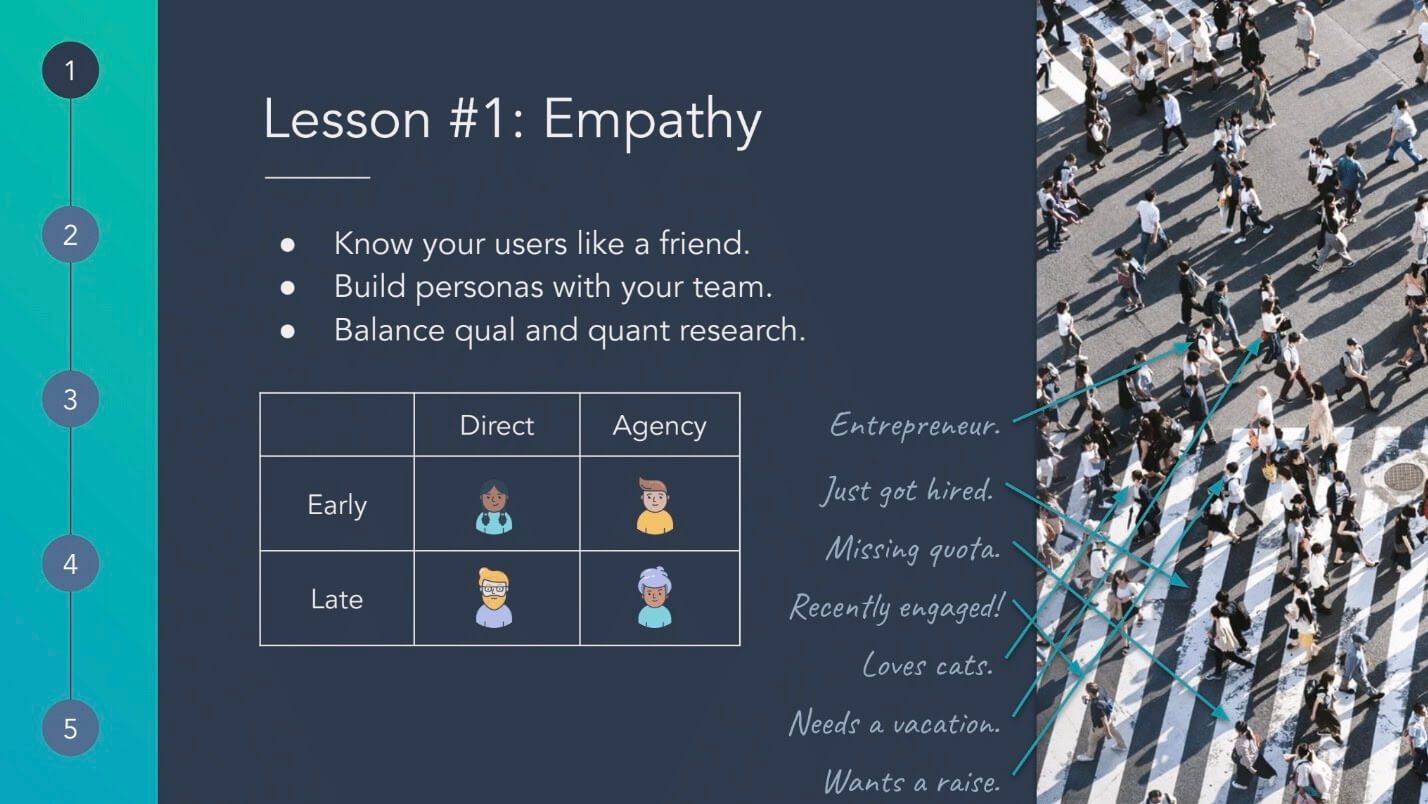
When I started at HubSpot, I was a data monkey. I was like, I can find out everything I need to know about these users from pivot tables, behavioral analytics, and that's it. What I would get is this top-down view, you can see the traffic congestion in the streets, you can see where there's friction, for sure.
But you can't see that this person just joined the company, and is learning 20 pieces of software along with this one and can't even remember which username they need to sign in with.
You don't know this person needs a vacation and they're ready to sign up for your product and then leave for two weeks, and they look like a signed up and disengaged user but really, they're just on their honeymoon.
Build personas with your team
What I did was create this matrix you see here with our agency partners and our customers and our prospects.
I did user interviews with all of them. If there's one tactical thing for you to take away today, go talk to your prospects, go talk to your users, because you'll get so much more rich information out of them, then you will just by looking at data.
Balance qualitative and quantitative research
You have to combine quantitative research and qualitative research to really get the full picture. A perfect example of this, I do multiple user interviews per week and I had someone from France a couple of weeks ago.
I asked them how would you find a social media course in HubSpot Academy? I had them show me their screen on Zoom, and show me what they would do. If you can imagine like a typical online course provider has filters, has a search bar, lots of ways they could have scrolled down.
They hit CTRL+F, typed the word social, and it highlighted the social media course in HubSpot Academy. We would have never known that control find was the way you would find social media in the course unless we talked to them and actually watched them do that.
My designer is sitting on the call, fly on the wall and I thought "I need to buy her a doughnut because that probably frustrated the heck out of her".
So know your users like a friend, builds personas, really deep rich personas, and then balance that quantitative and qualitative research. User interviews are really powerful for bringing a lot of rich insights but you can't rely just on user interviews you need them with the quantitative data too.
Lesson 2: Positioning
Now we had an idea of who we were talking to and when we did these user interviews, we saw this clear dichotomy between two groups.
There were the people who were focused on the certification you would get after taking the course - our customers and partners generally wanted to prove their knowledge, show they had attained some level of knowledge. We had hiring managers, our customers, who would onboard new employees, and they would say "Take the certification and show me once you got it. Good. You're onboarded".
There were other people like freelancers and students and job seekers, they all were very focused on their credentials, the batch, the certification.
But those weren't really ones I was focused on, as an acquisition channel I needed marketing managers, VPS of marketing, people who might buy software sometime in the next 90 to 100 days.
They didn't care about the credential at all. They cared about the course - they wanted to stay up to date on the latest digital marketing tactics.
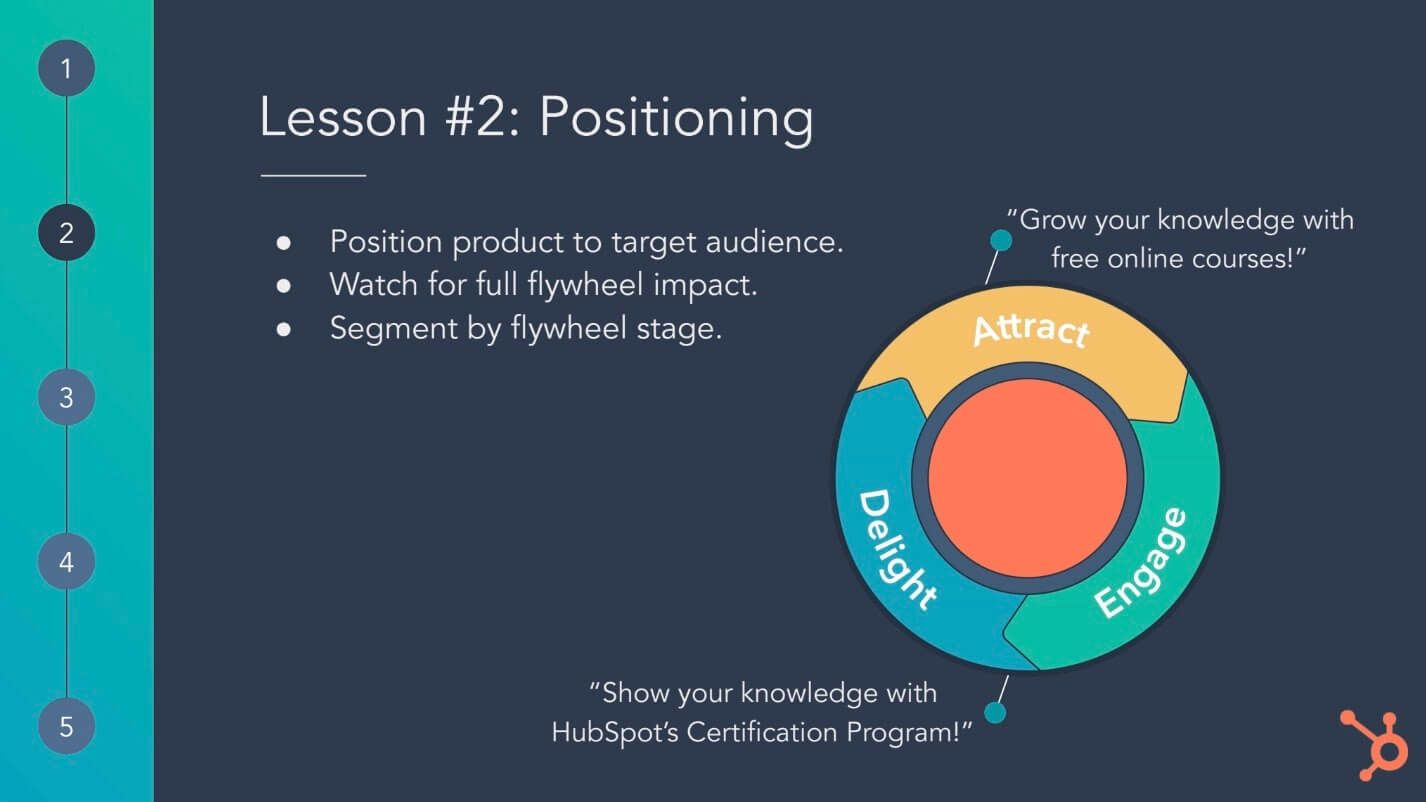
Position product to target audience
We realized the way they were talking about HubSpot Academy they were talking about the courses, not the certifications.
While we have marketed HubSpot Academy as a certification program this whole time, HubSpot certification program, we really needed to be marketing it as an online course provider.
That positioning switch, basically positioning HubSpot Academy for a different part of the flywheel, really dramatically changed the number of people we could get.
Because if you think about it, and you go back to the point about how you can influence perception through your customers, I needed those users to be able to tell their friends, "HubSpot has an online course provider".
I didn't want them to say "HubSpot has a certification program". Because HubSpot having an online course provider sounds applicable to so many more people. It's so much broader than HubSpot has a certification program because that's more like why would you get a scuba diving license if you don't know what scuba diving is.
You don't want a certification unless you're an actual HubSpot user or you need to show that on your resume, you need some credential to show you learned it.
Watch for full flywheel impact
For the prospects, for HubSpot as an acquisition channel, we really leaned into it as a course provider.
The trick here is to watch for the full flywheel effects because when we did that, we also attracted a lot of students, a lot of freelancers, people who generally we were happy to have in the ecosystem, love students, we have 1000 professors now teaching HubSpot Academy courses in their universities.
But they don't necessarily buy software immediately or they don't buy software within the next three to six months so they kind of weighed and balanced our MRR per sign up.
Segment by flywheel stage
Segmenting the flywheel by each stage, and then positioning depending on which stage you're bringing people into or communicating people with was key.
Lesson 3: Growth levers
At this point, we know who we're talking to, and we know how to talk to them. It's time to put some gasoline on the fire. We were looking for growth levers.
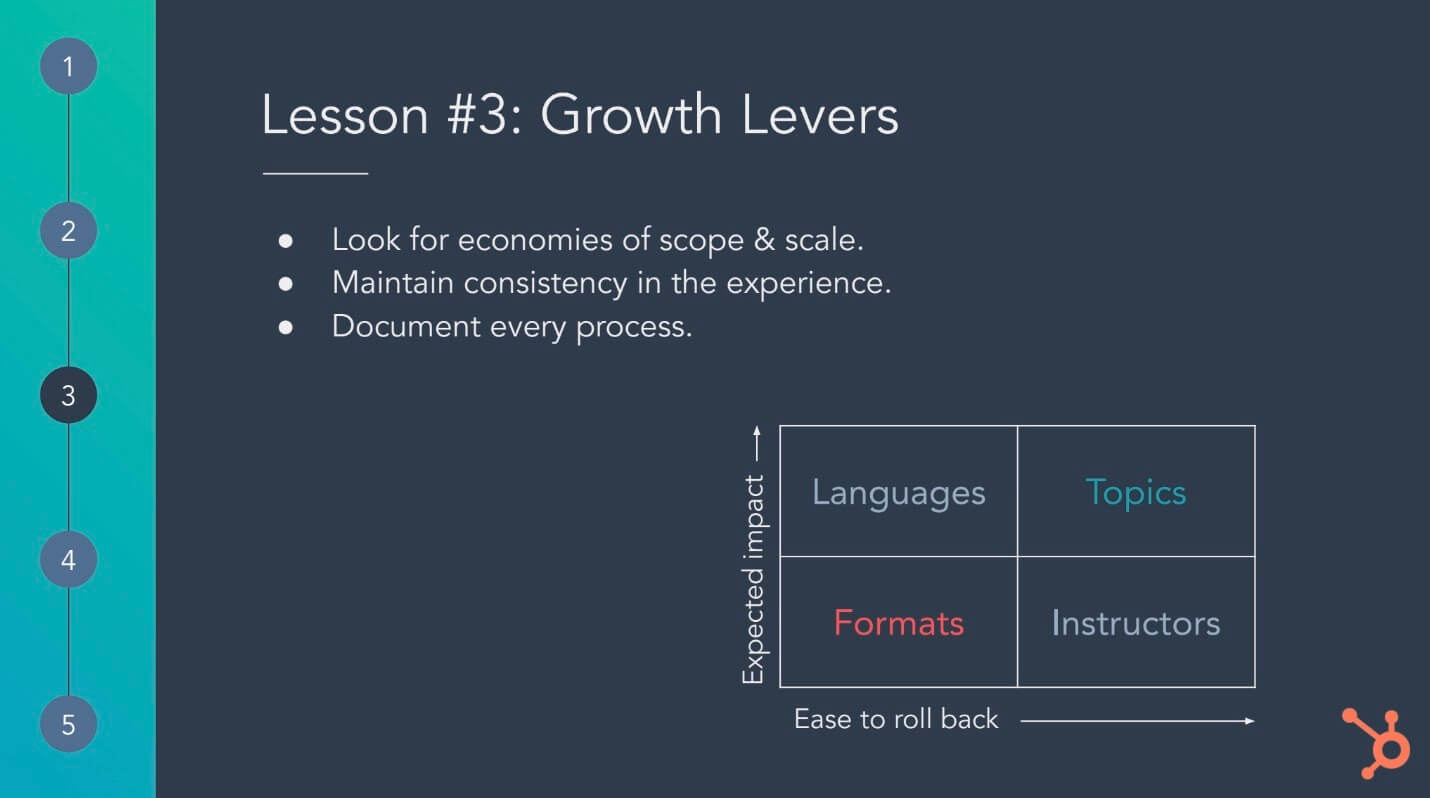
Look for economies of scope and scale
We're thinking, how do we grow this thing fast? We have somehow achieved product-market fit. Our users basically told us, they said, "We want this course in Spanish and Portuguese". They said, "We want more advanced topics. You teach one class on SEO in the inbound marketing course, we want an entire course on SEO".
So we did both of those things. One of them worked out well, one of them worked out not so well. I'm going to start with the not so well.
Course in Spanish and Portuguese
We told ourselves we were localizing the inbound certification for LATAM. What we were really doing was translating it. We ran it through a vendor, we added the transcriptions and SRT files to the videos so they were subtitled.
We had our internal marketers for that region, check it - not very good QA people, because they already knew all the answers to the certification exam.
Maintain consistency in the experience
What we learned was that these prospects, these users, they're super emotionally engaged. They're doing this for their career. I like to think about HubSpot Academy like it's a B2C product within a B2B product because they're doing this for their career, this isn't their marketing automation software they're worried about.
This is I want to put food on my table, I need that promotion, I want to get my kids to camp this year, they're serious about this stuff. So when the test question doesn't match up in wording with the course video, they're annoyed.
They're like, "Dude, I should have this certification. But because you didn't translate it perfectly, I don't". All hell breaks loose, tonnes of support tickets, we're trying to fix this, we can't roll it back, you can't release a new language to 1000s of people.
We had 80,000 people in LATAM on our database at that point. They're all excited about taking this course and they're all failing it. Pass rates were significantly lower than in English.
So we have to just keep working at it, we had to go in and modify and tweak videos, tweak transcriptions.
What we learned was there's this matrix for growth levers, how easy they are to test, we really should have released that to beta to 20 people in Portuguese, because we would have definitely learned a lot more than if we just had our internal marketers take it and pass it.
And then their ease to roll back. How difficult is it to roll this thing back if it doesn't work out? That was languages.
Topics
The other one our users were asking for were topics like I said. That generally worked out well. It took a lot longer to create those courses, twice as long, we'd have to bring in experts to teach them.
We released an email marketing course, a content marketing course, we brought in our postmaster email product VP to teach the email deliverability class. Really detailed advanced email marketing tactics. That worked out well.
We drove a tonne of demand, we grew the footprint of HubSpot Academy for search engines. We were able to rank for email marketing training, content marketing training, still do.
With growth levers, keep in mind which ones are easy to roll back and test, build your MVPs, etc.
Lesson 4: Platform-thinking
At the end of the day, HubSpot Academy is a platform. It's a content platform. My team creates an app, my engineers and my designers worry about this application.
And it's kind of like the stage, people don't come to the show for the stage, they come for the show. The content is the product, in this case, not the application where you see the content.
So when we build new features we have this decision to make, do we build tools for the content creators to bring that experience into the course? Or do we build that experience directly into the course and make it centralized? That's tricky.
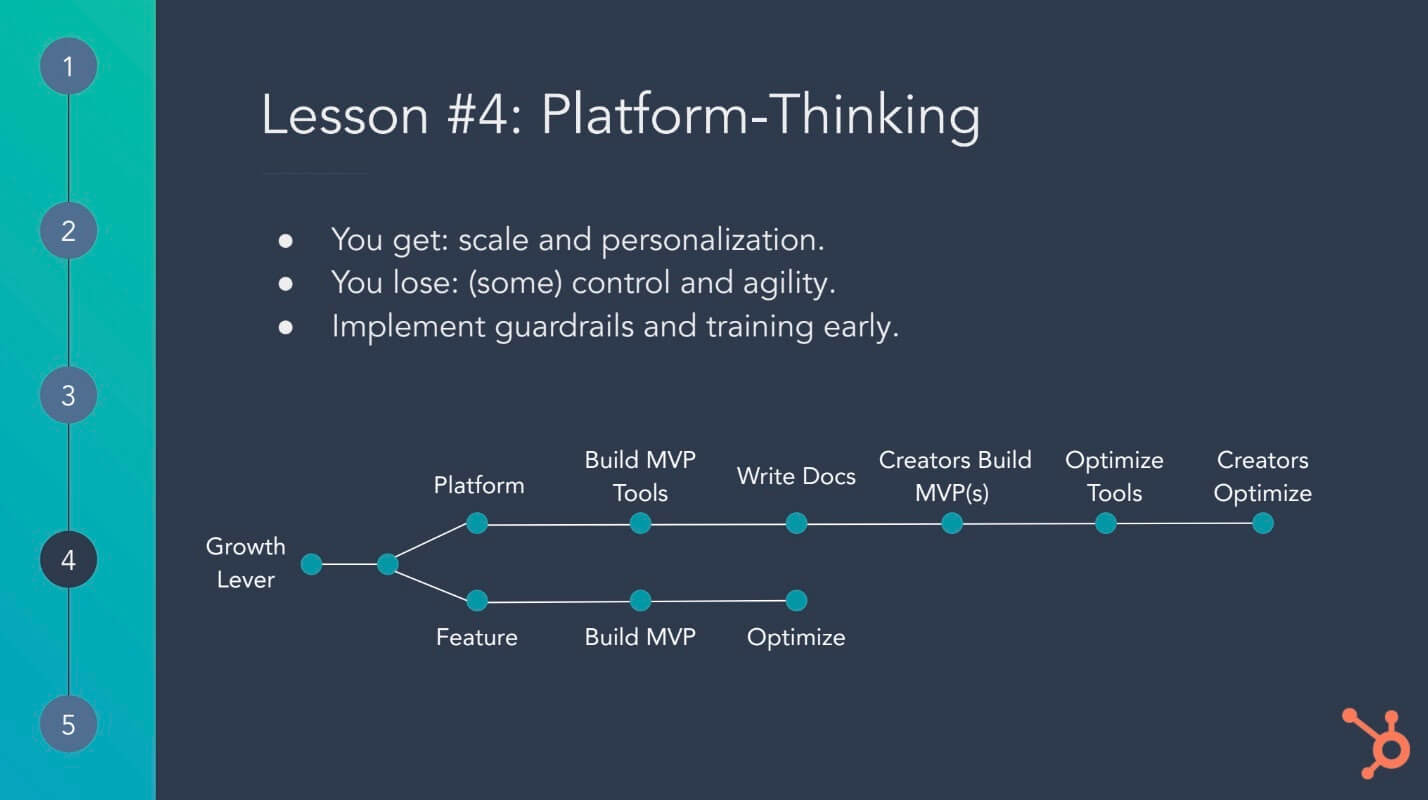
Example: Practical exercises
One example of a feature like that is practical exercises. If you think about what an online course is made of, it's made of video assets, quiz assets, text assets. So we created this new asset type called practical exercises. HubSpot had come out with all these free tools and really dove heavily into freemium strategy.
We thought, okay, if we can get all of our course takers to apply what they're learning in the free tools, then we'll introduce them to the free tools, maybe they'll start using them, maybe they'll upgrade one day, but really, they'll be able to apply, they'll reach a higher level of learning because they'll be able to apply what they're learning. Made sense.
90% of the time this works out, the content creator writes up "Go do this thing in HubSpot", they answer an event to flag when the user has finished it. Say they want the user to go create an email and send it, they say "Go create an email and send it" and then they plug in the event, 'user sent email' and then once they fire that event, it checks off as complete.
Great. We took them into the email application, brought them back to HubSpot Academy and they've officially done their practical exercise.
5% of the time, this totally doesn't work at all, whether that email application is in beta, and it's firing different events, for some reason, or some language doesn't have the practical exercise but another one does.
There are all these use cases we didn't expect and that's certainly true with platform features, you have this much longer feedback cycle between your MVP of the tools and the way those content creators use the tools to create their own MVP.
You get: scale and personalization
So with platform thinking, I think my advice is to keep in mind that while you get awesome scale, you can obviously create a lot more practical exercises with a team of content creators doing it than us doing it centrally.
And you get a lot more creativity because they know the learning outcomes of those courses, they know exactly what they want to achieve with those courses.
You lose: (some) control and agility
You also lose some control, and you lose some agility because it takes a lot longer to get that feedback loop back from that second level of users. We think of our content creators as users, we think of their learners as users too.
Implement guardrails and training early
Since then, we've learned with any platform features, we need to really implement a lot of guardrails, a lot of training, make sure the contributors are staying up to date on which events they're using in those practical exercises, things like that.
Lesson 5: Fight friction
Finally, there are new superheroes at SaaS companies called friction fighters, and we use the flywheel to measure our impact on HubSpot.
HubSpot Academy is the flywheel in itself. HubSpot is a bigger flywheel in itself, and they help turn each other if you think of it.
Force & friction
Anything that improves the force of the flywheel gets it to turn clockwise. Good.
Anything that slows down that force, any friction, bad.
So it's not all just about removing friction, it's about improving force too, increasing the total amount. That's what those growth levers are for - getting more demand and speeding up the flywheel too.
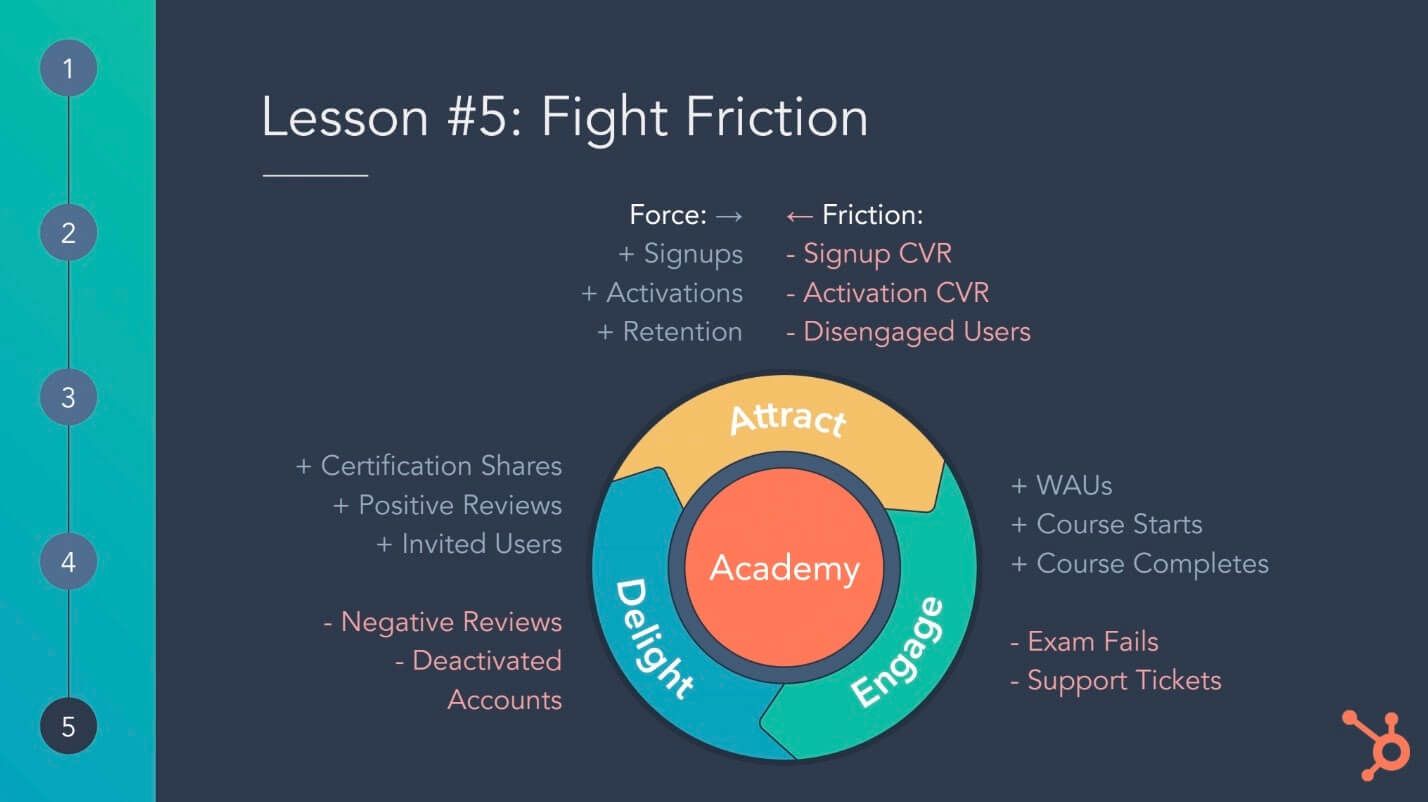
And so we're actually measuring force and friction at each stage of the flywheel and how we can remove friction and add force. That's been super powerful.
A couple of cool things have happened since we've equalized - since HubSpot Academy has become more or less 50% acquisition, 50% free Academy users using free tools, and 50% customers and partners learning HubSpot, learning how to sell HubSpot, etc.
We even have developer courses in there now teaching people how to build on HubSpot. We have our HR team or our people ops team is adding courses for attracting new employees to HubSpot. It's really a platform for any team at HubSpot to create online education to achieve their goals.
But some cool things have happened.
HubSpot Academy courses as a litmus test
For one, we've learned that our product team uses HubSpot Academy courses as a litmus test for the market.
Example: Instagram
We released an Instagram marketing course that got 2,000 signups on the first day because Instagram is this mystical topic right now, nobody really nails it.
That really told our product group who is creating the Instagram tools in HubSpot (HubSpot has a whole set of social tools, Instagram is one social network):
- It's important to really focus on that
- There's a lot of demand for Instagram marketing
- It takes a lot less time to create a course than it does to create a feature in HubSpot
- Use us as this listening device in the market for
- What is there a lot of demand on?
- What are people having challenges with?
If they're willing to go sign up for a four-hour course and learn, then they probably have a pretty significant challenge in that space.
To conclude
Build empathy
Remember, build empathy with your users. Develop those rich personas, they do so much for your product and for your growth team to have a clear picture of who they're working towards. Because they're all having very different experiences with your product.
Adapt positioning
Adapt your positioning to the audience you're targeting.
Identify growth levers
But remember how easy they are to pull back and to roll back and build MVPs.
Build a platform
But again, keep in mind the additional complexities of multi-level feedback.
Fight friction
Always be fighting friction and growing force.
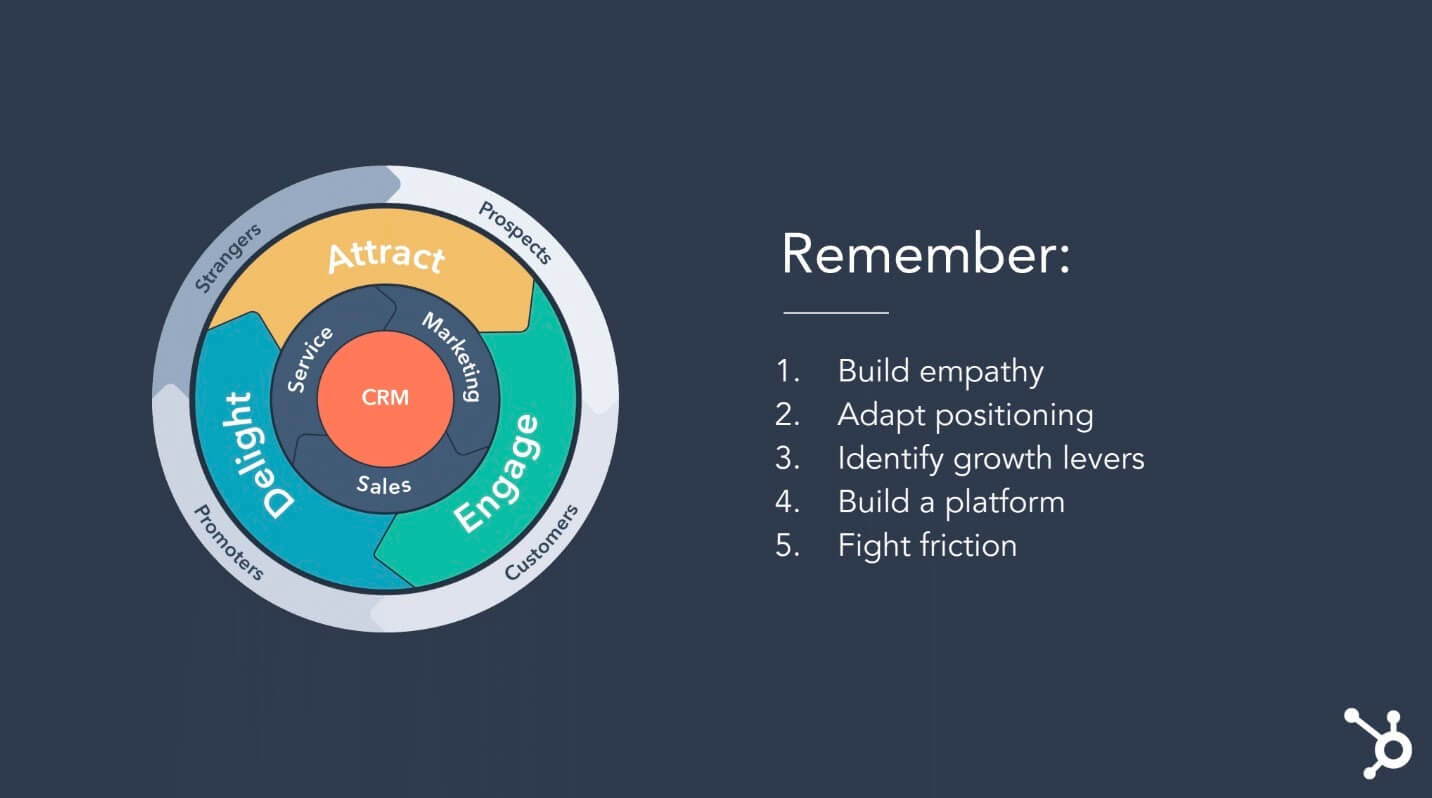
Thank you.



 Follow us on LinkedIn
Follow us on LinkedIn



